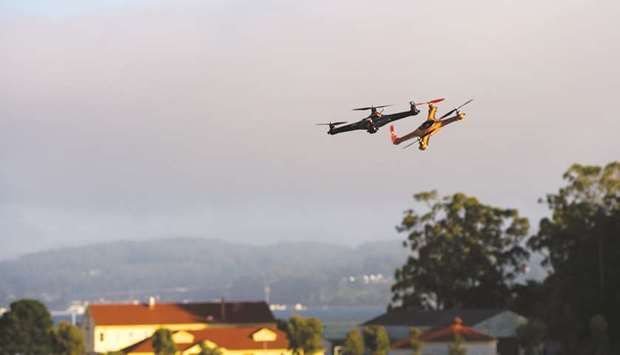More than 800 flights were cancelled from London’s Gatwick last month due to disruptions caused by the illegal and dangerous drone operations at one of the UK’s busiest airports.
The flights disruption affected an estimated 100,000 passengers whose Christmas travel plans had obviously gone awry.
Any midair collision with an object is dangerous to the aircraft, as illustrated by the crash of a US Airways flight, way back in January 2009.
Captain Chesley Sullenberger had then steered a passenger jet into the Hudson River after it hit a flock of Canada geese, shortly after taking off from La Guardia airport in New York City.
The birds destroyed both the aircraft engines, although some 155 people had a providential escape in the incident, which has since come to be known as the ‘Miracle on the Hudson’.
The weight of a Canada goose – said to be between 2kg and 6.5kg – is often exceeded by some professional-quality camera drones. Pilots have called for more testing on the potential impact of a drone on an engine – tests that manufacturers routinely apply for bird strikes – but this would be expensive, according to The Guardian newspaper.
New research suggests that small unmanned aerial vehicles (UAVs) can actually be much more damaging than birds at the same impact speed, even if they are of similar weight.
The study, published by the Alliance for System Safety of UAS through Research Excellence, a think-tank, used computer simulations to examine the impact of bird and UAV collisions in more than 180 scenarios. The researchers found that the drones’ rigid and dense materials — such as metal, plastic and lithium batteries — can put aeroplanes at much greater risk than a bird carcass.
A researcher said that in every collision scenario (with a drone) there was at least minor damage to the plane and sometimes it was much more severe. In one case, the researchers discovered that if a drone were to hit an aircraft’s fan blades when it is operating at its highest speed, the blades could shatter and snap power to the engine.
The successful ditching of the US Airways jetliner into New York’s Hudson River proved that it is really possible to land an aircraft on water!
But what is really alarming is the fact that incident highlighted how dangerous birds can be to aircraft, particularly when they get sucked into engines.
If an aircraft wing struck a drone, it would probably cause damage but no danger to the plane. But a drone that is being sucked into by an engine could be much riskier, wrote The Independent newspaper.
While bird strikes are relatively frequent, and passenger aircraft are perfectly capable of flying with one engine out of action, there are concerns that a metallic object containing lithium batteries could cause an uncontained failure, with debris impacting on the airframe. Pilots also seem to be worried about a drone striking an aircraft windscreen, or a helicopter rotor.
That said, airlines around the world take safety risks very seriously. Their global association, IATA, warns of “an exponential increase in reports of remotely piloted aircraft (RPA), operating dangerously close to manned aircraft and airports.”
They have also expressed concerns about the financial impact of disruption caused by drones flying close to airports, since the diversions and delays at Gatwick alone had cost tens of thousands of pounds!
“Safety is the number one priority of the air transport industry and the commendable patience of passengers is appreciated while the authorities ensure that there is no threat from drone activity to civil aircraft,” IATA noted following the recent Gatwick incident.
Industry analysts say the rogue drones menace can be curbed only by identifying the operators of such unmanned aerial vehicles and bringing them to justice.
They suggest measures to accelerate co-operation among the industry, drone manufacturers and governments to reduce the risks of rogue drone operations.
Such measures could include greater education and awareness for drone operators, a registry of drones above a certain level of capability, enhanced fines and prison sentences for offenders, and technological solutions to prevent drones entering restricted airspace.
According to industry experts, the law that is generally accepted is that it is illegal to fly a drone within 1km of an airport or airfield boundary and flying above 400ft (120m), which increases the risk of a collision with a manned aircraft – is also banned.
Endangering the safety of an aircraft is also a criminal offence, which can carry a prison sentence for a specific period.
The vulnerability of most airports is all too apparent when it comes to rogue drones, and therefore only tougher laws can deter unprincipled operators of such unmanned aerial vehicles.
Pratap John is Business Editor and Chief Business Reporter at Gulf Times

Drones fly during a demonstration at the Bloomberg Next Big Thing Summit in Sausalito, California (file). New research suggests that small unmanned aerial vehicles (UAVs) can actually be much more damaging than birds at the same impact speed, even if they are of similar weight.



